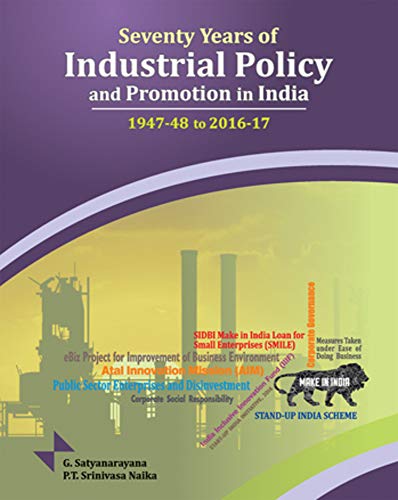P T Srinivasa Naika Satyanarayana (3 results)
Product Type
- All Product Types
- Books (3)
- Magazines & Periodicals
- Comics
- Sheet Music
- Art, Prints & Posters
- Photographs
- Maps
-
Manuscripts &
Paper Collectibles
Condition
- All Conditions
- New
- Used
Binding
- All Bindings
- Hardcover
- Softcover
Collectible Attributes
- First Edition (1)
- Signed
- Dust Jacket
- Seller-Supplied Images
- Not Printed On Demand
Seller Location
Seller Rating
-
Seventy Years of Industrial Policy and Promotion in India
Published by New Century Publications, 2017
ISBN 10: 8177084518ISBN 13: 9788177084511
Seller: Books Puddle, New York, NY, U.S.A.
Book
Condition: New. pp. 350.
-
Seventy Years of Industrial Policy and Promotion in India
Published by New Century Publications, 2017
ISBN 10: 8177084518ISBN 13: 9788177084511
Seller: Majestic Books, Hounslow, United Kingdom
Book
Condition: New. pp. 350.
-
Seventy Years of Industrial Policy and Promotion in India : 1947-48 to 2016-17
Published by New Century Publications, 2017
ISBN 10: 8177084518ISBN 13: 9788177084511
Seller: Vedams eBooks (P) Ltd, New Delhi, India
Book First Edition
Hardcover. Condition: New. 1st Edition. Contents: 1. Indian industry during British rule. 2. Industrial repression and slow growth: 1947-1985. 3. Industrial liberalization, privatization and openness since 1985. 4. Constitutional provisions and legal framework for industrialisation. 5. Institutional set-up and support for industrialization. 6. Industrial Policy in India s Five Year Plans (I to XII Plan). 7. Recent initiatives for industrial development. 8. Public sector enterprises and disinvestment. 9. Micro, Small, and Medium Enterprises (MSMEs): role and organizational set up. 10. Micro, Small, and Medium Enterprises (MSMEs): problems and remedial measures. 11. Micro, Small and Medium Enterprises (MSMEs): sector-wise profiling. 12. Industrial Finance and Development Finance Institutions (DFIs). 13. Infrastructure for industrial development. 14. Tax incentives for industrialisation and infrastructure development. 15. Foreign Direct Investment (FDI) for industrial development. 16. Industrial relations, labour laws and industrial sickness. 17. Corporate governance and corporate social responsibility. 18. Entrepreneurship development and innovations. 19. Industrial development and environment. 20. Indian Industry and World Trade Organization (WTO). Glossary of Industrial Terms. Bibliography. Index. The industrial environment in India during 1947-80 was characterised by strong centralised planning, Government ownership of basic and key industries, excessive regulation and control of private enterprise, trade protectionism-through tariff and non-tariff barriers-and a cautious and selective approach towards foreign capital. It was a quota, permit and license regime guided and controlled by a bureaucracy trained in colonial style. Domestic competition was restricted, leading to lack of quality and cost consciousness in most segments of the industry. The level of protection offered to Indian industry, by way of qualitative import restrictions and tariffs, was unreasonably high, leading to high costs of production and inadequate technological dynamism. This so-called inward-looking, import-substitution strategy of economic development-which failed to lay strong foundations for the future development of the country-began to be widely questioned with the beginning of 1980s. Policy makers started realising the drawbacks of this strategy which inhibited competitiveness and efficiency and produced a much lower rate of growth than expected. Pressure was, therefore, mounting for industrial liberalisation owing to a host of internal and external factors. Tilt towards economic liberalisation started in 1985 when Government announced a series of measures aimed at deregulation and liberalisation of industry. These measures, described as the New Economic Policy, were followed by drastic changes introduced by the 1991 Industrial Policy Statement of the Government. As a result of economic reforms of the last 25 years, India is presently one of world s fastest growing economies. In the last few years, it has emerged as a global economic power, leading outsourcing destination and a favourite of international investors. Indian industry has upgraded technology and product quality to a significant degree and met the challenge of openness after being protected for so long. Recently, the Government has launched a number of programmes/schemes to rejuvenate and modernize the Indian industry. These have included, inter alia, Start-up India Initiative, 2016, eBiz Project, Make in India Campaign, Stand-up India Scheme, Ease of Doing Business, India Aspiration Fund (IAF), Atal Innovation Mission (AIM), India Inclusive Innovation Fund (IIIF), Digital India, and Smart Cities Mission. This book contains 20 chapters which trace developments in different fields of industrialization in India during the post-Independence period. The book also explains the post-1991 key reform measures undertaken for making Indian industry internationally competitive. Current issues pertaining to this vital sector of.


